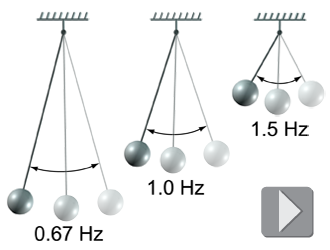|
 If you experiment with a pendulum you observe a curious fact: It always oscillates with the same frequency. For example, a certain pendulum completes one cycle every 1.5 s (0.67 Hz). Every time you set the same pendulum swinging, it always swings with a frequency of 0.67 Hz and never changes its frequency. The frequency at which a system tends to oscillate is called its natural frequency. Everything that can oscillate has a natural frequency, and most systems have more than one. The natural frequency depends on the balance between the strength of restoring forces and the amount of inertia in the system.
If you experiment with a pendulum you observe a curious fact: It always oscillates with the same frequency. For example, a certain pendulum completes one cycle every 1.5 s (0.67 Hz). Every time you set the same pendulum swinging, it always swings with a frequency of 0.67 Hz and never changes its frequency. The frequency at which a system tends to oscillate is called its natural frequency. Everything that can oscillate has a natural frequency, and most systems have more than one. The natural frequency depends on the balance between the strength of restoring forces and the amount of inertia in the system. 
|
Natural frequency
|

| The natural frequency is useful because many inventions are designed to work at a specific frequency. For example, a guitar string that plays the note middle C is tuned to have a natural frequency of 262 Hz. The process of tuning is really a process of adjusting the natural frequency of a vibrating string oscillator. Watches, computers, and many devices rely on the precise natural frequency of quartz crystal oscillators. A computer that advertises a speed of 2.6 GHz has an internal quartz clock that oscillates at a frequency of 2.6 billion cycles per second. |

|
If the restoring forces in a system are strong, then the system accelerates quickly and tends to have a higher natural frequency. A steel guitar string takes much more force to deflect than a rubber band of the same length, because rubber is a much weaker material than steel. The guitar string has a much higher natural frequency because of the higher restoring force created by steel compared to rubber. 
|

|
A system with more inertia is harder to accelerate and responds more slowly. Adding inertia therefore lowers the natural frequency. The bass strings on a guitar are wound with extra wire to make them heavier. The increased mass creates more inertia and causes the strings to oscillate more slowly, which means that the natural frequency has been lowered. Tying a steel nut onto a rubber band will produce the same effect. The added inertia of the steel nut greatly lowers the natural frequency of the system. 
|
Why does blowing over the top of an empty bottle produce a note?
 |
Your breath causes the air in the bottle to vibrate at the system’s natural frequency, which is dependent on the height of the air inside the bottle. The vibrating air produces an audible note.
The bottle acts like a musical instrument such as a guitar or trombone, where the length of the system can be varied to change the natural frequency and thus produce a different note. 
|

